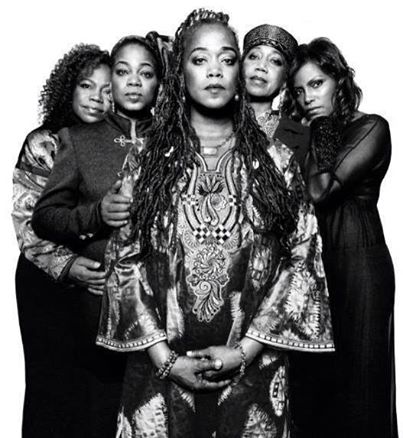
Malcolm X’s daughter’s from Locs and braids http://40.media.tumblr.com/2f6d070e47cb897a33f96dea06355419/tumblr_n1k4n7tfdp1ql1ezbo1_500.jpg
Often, when we talk about the history of Islam in America, we focus on the great men and their big ideas.This month in looking at the BlackLivesMatter Movement through the life and legacy of Malcolm X, I have often thought about the thought of the many women who were were also part of the our nation’s freedom struggle. Many Muslim Americans know about Malcolm X, but few know about the women in his life. Few of us consider the role that many of our sisters who were pioneers of establishing Islam in America, such as Clara Muhammad the wife of Elijah Muhammad. Just as we remember Malcolm, we should know about Ella Collins, Betty Shabazz, and his daughters Attallah Shabazz, Qubilah Shabazz, Ilyasah Shabazz, Gamilah Lumumba Shabazz, Malikah Shabazz and Malaak Shabazz. All of these women have carried the burden of maintaining his legacy. And if we are the honor the man, we should acknowledge the women who contributed to his life and help maintain his memory.
While few of us recognize Ella Collins (1914-1996) as a seminal figure in American Muslim history, the Islamic Society of Boston Cultural Center honors her civil rights legacy with the Ella Collin’s Institute (ECI). The half sister of Malcolm X, she was responsible for recruiting Malcolm X into the Nation of Islam, although Spike Lee’s film biopic of Malcolm X erased her. Throughout his life she was influential, having helped raised the young Malcolm Little after his father was murdered and mothered suffered a nervous breakdown. She was an activist who had worked for the first Rev. Adam Clayton Powell. According to her obituary, Ella Collins advised her half brother to embrace orthodox Islam and she funded his pilgrimage to Mecca. After his assassination, Ella Collins maintained the Organization for Afro American Unity after his assassination. While her role in supporting Malcolm X is noteworthy, Ella Collins’ life history as a business woman who set up schools and worked in civil rights is noteworthy in and of itself. By looking at her life, it becomes clear that women played a central role in the civil rights movement and in instituion bulding in the Black American Muslim community.
Betty Shabazz (1934-1997) was invited to Nation of Islam meetings. After attending several meeting wehre Malcolm X preached, she joined in 1956. Following two years of courtship, they married in 1958. Betty Shabazz was pregnant with twins, when Malcolm X was assissinated. Raising her six daughters alone, Ruby Dee and Juanita Poitierr (wife of Sidney Poitier) raised funds to provide her a home and the royalties to the Autobiography of Malcolm X supported the family. Shabazz returned to school and eventually earned a doctorate in education from the University of Massachusetts in 1975. She became a college administrator and public speaker, often defending her husband’s legacy and discussing topics such as civil rights and racial tolerance. Her life also ended tragically, when she succumbed to her burn injuries from a fire her grandson ignited.
Although she was wife of one of the most influential thought leaders in the civil rights movement, Betty Shabazz’s life history also provides a nuanced narrative of Black American life. She was a middle class, college educated Black woman who faced racism. She negotiated gendered norms in her marriage to develop a partnership with her husband. In addition, by putting Malcolm X’s life in context, we can take a critical look at ourselves in the sunni Muslim community, which failed to support Malcolm’s burial or his widow. Yet now, we find a sense of rootedness in his legacy. And when we talk about his legacy, how much do we honor the women who were closest to him.
It would do a great disservice to speak about Malcolm X’s legacy without talking about his heirs. We should know their names and their struggles because they have largely born greatest burden in the loss of malcolm x. We should know more about Attallah Shabazz, Qubilah Shabazz, Ilyasah Shabazz, Gamilah Lumumba Shabazz, Malikah Shabazz and Malaak Shabazz. Attallah became involved in the arts and public speaking, Gamilah hip hop, Qubilah became embroiled a supposed plot to kill Louis Farakhan, Ilyasah Shabazz became a public speaker and author of Growing Up X and a children’s book titled Malcolm Little: the Little Boy Who Grew up to Become Malcolm X . Malcolm X’s daughters, whose life histories are storied and triumphant reflect the turbulent years following their father’s assassination. Their day to day struggles is a topic worthy of study and reflection on Black American Muslim life in and of themselves.
Even separating their accomplishes from Malcolm X, these eight women point to extraordinary lives of Black American Muslim women. Centering women’s lives can give us a more nuanced sense of historical processes. Ella Collins shows us how social supports also played a role in supporting inspirational figures. Betty Shabazz provides a more nuanced picture of Black women in the 50s and 60s and how they navigated racism and gendered norms. Before the 1992 movie, while Malcolm X was being vilified and the sunni Muslim community largely distanced themselves from his legacy, it was largely Betty Shabazz and her daughters who maintained the Legacy of Malcolm X. We can’t truly honor Malcolm X’s legacy without giving thanks to the women who have shaped it.
